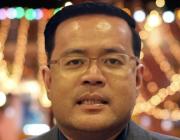Citation:

Abstract:
In Focus: An Interview with National Artist for Sculpture Napoleon Abueva by JOSE WENDELL P. CAPILIPosted online by the NCCA on 3 November 2003
Jose Wendell Capili (JWC): Have you always been interested in pursuing a career in fine arts? What were your earliest artistic endeavors?
Napoleon Abueva (NA): As far as I can remember, save for a bust of Rizal, probably purchased in Avenida Rizal, we did not have sculptural pieces in the house.
My career actually began when we were required to do gardening in primary school and high school. Through gardening, I made my initial contact with clay. As a child I made animal forms, especially of the carabao, out of garden clay. In my teens, I worked for Imo Ponce’s machinery in Cebu where I helped build small boats and handled milling machines.
Somewhere along the way, I got to meet artists and workers from various disciplines. I also worked part-time posting movie advertisements in street corners. In exchange, I watched movies for free. Watching films certainly expanded my vision of the universe. At some point, I became fascinated with religious images and I met Fidel Araneta who specialized in it. Araneta, by the way, was a student of National Artist Guillermo Tolentino at UP. I stayed in Cebu for two years.
My experiences with Ponce and Araneta empowered me to experiment with almost any kind of media—from iron to adobe, from steel to coral. My favorite medium, though, had been Philippine hardwoods: narra, kamagong, ipil, bamboo and molave. Looking back, I think it was good that I experienced handling machinery.
JWC: What happened after Cebu?
NA: I immediately returned to my home province, Bohol. In the capital town, Tagbilaran, I was fortunate to work with Jacob Tagorda, the District Engineer of Bohol. Under Mr. Tagorda, I was assigned to the concrete fabrication area where I learned how to use concete in the construction of homes, roads, and bridges. I also did the “lapida” and other sculptural pieces in cemeteries. I used white cement.
Around this time, I studied high school at Rafael Palma College. When I graduated in 1949, I moved to UP Diliman. I think I belonged to the second batch of Fine Arts students who moved from the old campus in Padre Faura.
JWC: Why did you decide to study in UP?
NA: I made it to UP Fine Arts because I was strongly encouraged by my eldest brother Teodoro. He now lives in New York. He was my big influence, my father figure. He finished Political Science at UP. My brother was responsible for introducing me to Pura Villanueva, art patron and the country’s first Carnival Queen in 1908 who later married pre-WWII Batangas Assemblyman Teodoro M. Kalaw.
My brother knew Ms. Ledesma, Ms. Villanueva-Kalaw’s daughter. Ms. Villanueva-Kalaw offered me a scholarship and I was able to study under the tutelage of National Artist Guillermo Tolentino. She had other scholars, many of them in the field of literature: Andres Cristobal Cruz, G.Burce Bunao and Morli Dharam. Jose Joya was my contemporary. Federico Alcuaz was there too but he had decided to study in Spain.
JWC: You lost your parents during the Second World War. How did this affect your subject-position as an artist?
NA: The experience allowed me to treat life with greater sensitivity. My father was a congressman representing Bohol. My mother, on the other hand, was the head of the Women’s Auxiliary Service (WAS). They were executed by the Japanese in 1944 for supporting the guerilla forces against the Japanese invaders. The Kempetai (Japanese Military Police) separated my parents from us. The Japanese tortured my parents and forced me and my siblings to listen to their pain and agony. Later, we were taken to a cliff where my parents were rumored to have been executed.
We sought the remains of our parents from a field of corpses and items belonging to the members of the resistance group. It was painful for me and my siblings to unearth the soiled white shirt with blue stripes, which belonged to my father. We also found a piece of my mother’s dress as well as her rosary. Later, we found my parents’ bodies and we buried them. It was very painful. As an artist, these experiences taught me to see life in a different way. More specifically, I tried my best to look for new ways of expressing ideas as a way of dealing with the pain.
JWC: Your brother solely took care of you when your parents passed away?
NA: We stayed with my aunt Isabel Balce. The Balces took care of me and my brother Teodoro. She originally wanted me to study at Cebu’s Institute of Arts and Trades. It was my brother who insisted that I should be taking a regular high school program. In the long run, it paid off since I was able to take regular humanities courses that enriched my interest in the fine arts.
JWC: You have been so productive from the 1950s onwards, even more so after your retirement from UP Diliman. What are some of the determinants that caused these?
NA: Perhaps, I have been blessed with good health (laughs).
JWC: Did you have influences to sustain this energy?
NA: Guillermo Tolentino, my mentor at UP. From 1950-53, I had the good fortune of assisting my Maestro in the creation of some of his works. He was conservative since he belonged to the old, classical school. His concept and attitude towards the depiction of the human form is akin to that of the Greek sculptors during the year of Phidias, where there is always the stance of the heroic and the monumental epic in portrayal aside from faithfully interpreting the subject. Eventually, he became involved with the spiritist school. He challenged me a lot. Tolentino really abhorred distortion and when “The Kiss of Judas” won a prize, he jokingly referred to it as “the monster.”
I moved on, and although we disagreed on many points, he was nevertheless encouraging. He was a very good teacher and he was very happy with what I managed to achieve.
JWC: Can you kindly explain how you became what critics refer to as “a pioneering modernist in sculpture?”
NA: After the Liberation of the Philippines from Japan, the United Nations sent to the Philippines a number of experts on arts and crafts. For instance, John Resley, a sculptor and Mrs. Murphy, the head of the UN delegation and a relative of American Governor-General Frank Murphy, taught new styles and ideas to upgrade the quality of design in the country. The UN sent all kinds of artists and artisans: painters, sculptors, weavers, etc. Resley taught me how to experiment with wood. Tolentino was more into clay modeling. Resley was a carver. Resley was so fascinated with Philippine wood and I just got hooked on it.
Then I moved on and eventually experimented with adobe and other media. Then I wanted to pay tribute to my sister who died at stillbirth. I tried to make a floating coffin for her. I initially did not succeed. Eventually, my experimentations evolved into what became my “buoyant” sculptural pieces.
JWC: After receiving countless awards and citations from the Art Association of the Philippines and elsewhere, the university acknowledged your achievements and appointed you to various administrative positions. Did you ever think of administrative positions as a form of punishment?
NA: On the contrary, they were not a waste of time. They were opportunities to serve the university that nurtured me. Of course, I will always privilege doing something creative but being an artist and administrator at the same time enables you to infuse sensitivity in creating a healthier environment for students, faculty members, and staff.
JWC: Do you see any limitations to your being a sculptor?
NA: Writers have a great advantage over visual artists because writers can take down notes anytime, anywhere. Meanwhile, visual artists choose a specific medium to execute an interesting concept.
JWC: Why do some individuals become great artists, while others, unfortunately, do not?
NA: The inner drive. A more accomplished artist has inner drive and stamina. Now this is very important. The plight of the artist is somewhat similar to that of the long distance runner. You have to cross the finish line. What counts more in life is the end result. Leonardo da Vinci once said that the greatest tragedy of artists is when theory outstrips performance (laughs). Artists are judged by the end result. Theory is important but concepts must be executed very well for any theory to be realized. The artist must possess the inner drive, passion, and “loneliness” of a long distance runner to go very far.
JWC: Are there other reasons why you think you’ve gone this far?
NA: Luck has something to do with it. Hard work isn’t enough. The death of my parents maybe. Eventually, I translate emotions and transform these into pieces of wood, marble, clay, and so on.
JWC: What do you consider your most memorable pieces? At the AAP Contests during the 1950s, “Rice Planting,” “Kaganapan,” and “Figure” won first prizes; “Mother and Child” and “Father and Son” placed second. You even did the crucifix of the UP Chapel of the Holy Sacrifice. In the 1960s, “Allegorical Harpoon” was the Philippine entry during the XXII Venice Biennale and “Unknown Prisoner” was exhibited abroad. In the 1970s, “Bagong Buhay” and “Manila: The First Years” won AAP prizes. You also executed “The Transfiguration.” In the 1980s, you did “Siyam na Diwata ng Sining” and donated it to my college at UP. Were any of these particularly striking to you?
NA: “Rice Planting.” I think it now belongs to Ms. Ledesma. I heard it was being exhibited at the Museum of the Filipino People in the old Finance Department Building. I was greatly inspired by the song “Magtanim ay di Biro” and the painting depicts two women planting rice with salakots on top of their heads and santol trees in the background. I also like “Kaganapan” because the form of a pregnant mother depicts the promise of a new life. There were other memorable ones for some reason or another. “The Transfiguration” maybe. And the mural I created for the Insular Life Building along Makati Avenue corner Ayala…
JWC: Which is going to be demolished soon…
NA: Right. The mural, though, is being removed piece by piece. Soon, the pieces will be put together in the new Insular Life Building in Alabang.
JWC: Any new projects?
NA: Many, many projects. The door of a parish chapel, “Diego Silang”, and a memory of your friend, Maningning Miclat, who passed away recently. One afternoon, I went to her wake at Funeraria Paz and did her mask. There are many other projects and they are all over my backyard. Some of these (pointing to some pieces) will be brought to Bohol, my home province.
JWC: How do you wish to be remembered?
NA: Perhaps I can share with you my concept of design. I posted it outside my house. The inscription says: “Whatever desire is expressed in form, one conceives in realm of design. The mind in the hand can falter or surpass: if you answer which one and how much was done by love.”

